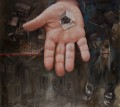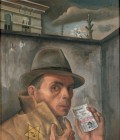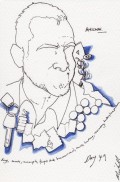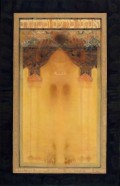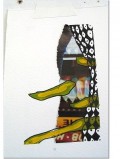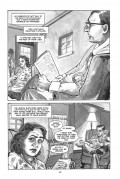Arts and Culture
Summer Shorts: Call for Submissions!
Attention fiction writers! ZEEK is proud to be launching a new summer fiction series this July.
Artist Q, Artist A: Yona Verwer Talks to Mirta Kupferminc
“Artists Are Communicators,” merging identities, the Argentine art scene, and what it’s like to be an international LABA fellow based in Buenos Aires.
Felix Nussbaum in Paris
Though murdered at Auschwitz, Felix Nussbaum painted his life, not his death. This article is from the ZEEK archive. It originally ran on December 14, 2010.
Artist Q, Artist A: Yona Verwer talks to Ken Goldman About his work, life, and new exhibit, Off Label
Artist Ken Goldman’s probing, sometimes seemingly irreverent art is a catalyst for provoking people into re-evaluating their preconceptions. By pushing boundaries, writes Yona Verwer, he searches for new opportunities to make Judaism more relevant to today’s life. Artist Q, Artist A is Zeek’s new series of artist-artist conversations.
Racism in the Art World: Avoid or Act? The Leftist Ethicist
I am an artist living in Chicago. When I go to an opening and see all white artists showing with a 99% white crowd or hear about residencies where it seems everyone accepted is white, I tune it out. As a white person, I am more myself in multi-racial settings. I’m not sure how to change this fact or even sure if I want to change it. Why force myself to connect in spaces that exclude people of color? Is my viewpoint “problematic,” as an activist friend claims? –Anti-Racist & Ambivalent in Chicago
Chalking History: 10 Years of Street Art Memory -- Honoring the Victims of the Triangle Shirtwaist Factory Fire
We honor the memory of the victims of the Triangle Shirtwaist Factory Fire of 1911 by doing what we can to advance safe working conditions, end sweatshop labor, and fight child labor and for immigrants rights.
This is the 10th year that volunteers have – thanks to Ruth Sergel of Street Pictures – chalked up New York City’s Streets to commemorate the 146 mainly immigrant women and girls who died in that fire and gave rise to a movement.
Relative Unknowns: When Images Outlast Memory, but Not Meaning
Most of us grow up in homes where a mix of historical and recent family photos preserve the family’s collective memory, linking present to past, and serving as a tangible way to honor and safeguard the memories of loved ones no longer with us physically. Yet our displays — like our memories — are selective.
Even as a little kid, I felt drawn most to the photos that didn’t make the cut. These, my mother kept relegated to a large, plastic bin in the upstairs closet. As soon as I could climb a ladder, I’d spend hours poring over the contents. I loved examining the faces of people I knew, witnessing their different hairstyles and dress choices over time.
Mendelssohn’s Tea Pot: How Artists Reinvent the Past, and the Jewish Future
Lately, virtually everyone I know who has some kind of association – professional, emotional, familial, religious or intellectual – with the American Jewish community has been reading tea leaves, trying to figure out, in the wake of the Pew Research Center findings, what the future might hold.
I, too, have been reading tea leaves (Darjeeling, anyone?), but the ones I find at the bottom of my tea cup belong to Moses Mendelssohn, the celebrated 18th-century German Jewish philosopher who sought valiantly to come up with a series of strategies to align Jewishness with modernity.
Art. Collaboration. Openness. Ritual. A “Sukkah Salon”
“In my art practice I’ve been frustrated by my discomfort with bringing my spiritual practice and identity into the objects I make,” artist Danielle Durchslag, co-creator of “Assembly Required: Sukkah Salon,” tells Zeek in this Q & A. “Somehow the two have stayed separate. This exhibition is an attempt to bridge those worlds.”
The Jewish Heart
Choreographer and dancer Jody Oberfelder reflects on home, heart, Judaism, and her newest creation, 4Chambers, a new experiential performance installation premiering this summer on Governors Island in New York. With onsite photos of the upcoming performance by Julie Lemberger.
Counting the Omer by Drawing
This year’s project began with a scratch of an idea. In preparation for Sinai, the receiving of the Torah, I wanted to explore what it means to hold on to something.
The Sacrifice of Abraham: Three Poems
Three poems from “The Sacrifice of Abraham,” a series of re-tellings of the biblical story of Isaac and Abraham. In each section, a group of rabbis gathers to re-tell and offer commentary on the story, and with each re-telling transforms it into a broader and broader vision encompassing Greek gods, revolutionaries, insurgents, love affairs, and photographic details from current events.
Shtus Jews Say: Jewish Memes, Jewish Identities
The variety of “Sh-t Jews Say” videos reveal much about how American Jews see themselves in relation to each other and to the society in which they live.
Appropriation or Reconciliation? Islamic Elements in the Art of Israeli Religious Women
Women religious artists have sought to reclaim a common, local, cultural space (artistic, religious and concrete ) whereby religion and culture constitute a common ground for connection, and not only a platform for dispute and conflict.
Winners of the 2012 Anna Davidson Rosenberg Poetry Awards
Zeek is proud to have again cosponsored the Anna Davidson Rosenberg Poetry Awards, and to be publishing the winners of this year’s contest: “Variation (Let’s Pretend) by Lauren Camp, and Excerpt from “Fantasy for the Shal Women” by Yosefa Raz.
Azriel Cohen: In Memoriam
All of us here at Zeek are deeply saddened to learn of the untimely death of Azriel Cohen, whose artwork has graced these pages many times. Here is some of Azriel’s diverse body of work, taken from different projects over the years.
Selichot in Krakow—Migration Sofa Melody
The only one of my mother’s melodies to remain is the sing-song of the shamash from the Remuh Synagogue in Krakow as he passed at night through the streets of the ancient ghetto, knocking on the window shutters and waking the Jews for selichot.
The Sephardic Poem
In Toledo we sat at a small round table
beside a rose garden and the synagogue,
our children grouchy from the long walk and the heat…
Not the Israel My Parents Promised Me
This is the last work of the late, great Harvey Pekar, who passed away two years ago at the age of 70: an autobiographical, narrative account of Pekar’s own relationship to the Land and State of Israel (which he never visited). It’s a political work, but primarily a personal story of lessons half-learned, allegiances formed and broken.
![[the current issue of ZEEK]](../../../image/2/100/0/5/uploads/leftistethicistgraphic-52842c6a.png)
- 5000 Pages of Zeek
- Founded in 2001, Zeek was the first Jewish online magazine, and we have over 5000 pages online to prove it, all available free of charge. Read more in the Archive.


